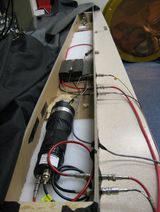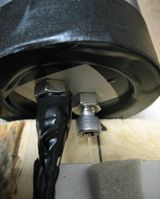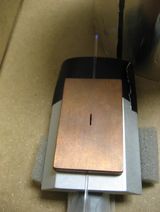Difference between revisions of "Fiber Test Stand at JLAB"
From GlueXWiki
(→Fiber Test Stand) |
(→Fiber Test Stand) |
||
| Line 1: | Line 1: | ||
=Fiber Test Stand= | =Fiber Test Stand= | ||
| − | * Purpose<br> The purpose of the fiber test stand at JLAB is do determine the number of photo electrons produced by a minimum ionizing particle in a scintillating fiber at a distance of 200cm from the fiber end. | + | * <b>Purpose</b><br> The purpose of the fiber test stand at JLAB is do determine the number of photo electrons produced by a minimum ionizing particle in a scintillating fiber at a distance of 200cm from the fiber end. |
| − | * Concept<br> One end of the scintillation fiber is coupled to the photo cathode of a PMT (XP2020). For monitoring purposes a second fiber (light guide) is also coupled to the same PMT providing light from a blue LED. At a given distance from the PMT surface a collimated Strontium (Sr90) source is mounted above the scintillation fiber. Below the fiber and the Sr90 source a small trigger scintillation detector (TSD) is mounted to trigger on electrons from the Sr90 source. The data acquisition is triggered by TSD and the analog signals from both the XP2020 and the TSD are digitized as well as their timing. Simultaneously a trigger is generated for the LED light source to monitor the XP2020 PMT during the measurement. | + | * <b>Concept</b><br> One end of the scintillation fiber is coupled to the photo cathode of a PMT (XP2020). For monitoring purposes a second fiber (light guide) is also coupled to the same PMT providing light from a blue LED. At a given distance from the PMT surface a collimated Strontium (Sr90) source is mounted above the scintillation fiber. Below the fiber and the Sr90 source a small trigger scintillation detector (TSD) is mounted to trigger on electrons from the Sr90 source. The data acquisition is triggered by TSD and the analog signals from both the XP2020 and the TSD are digitized as well as their timing. Simultaneously a trigger is generated for the LED light source to monitor the XP2020 PMT during the measurement. |
| − | ** Electronic layout<br> A basic sketch of the NIM electronics layout is shown [[Media:fiber_test_electronics_setup.pdf|here]]. <br>The signal from the XP2020 PMT is first amplified by a factor of 10 and then connected to a linear FAN In/Out. The DC offset of the linear FAN In/Out is adjusted such that the true pedestal is above the built in pedestal of the V972N VME ADC, which is about 5pC total charge. This corresponds to about 15mV of negative DC offset for the used gate width. The analog signal is then connected to the ADC adjusted for timing. A second output of the linear FAN In/Out is connected to a discriminator the output of which is then connected to F1TDC. The trigger scintillator is also connected to a linear FAN In/Out. Also here the DC offset is adjusted to move the true pedestal of the signal above threshold in the ADC. The analog signal is also discriminated and one output connected to the trigger OR which is linked to the trigger interface TI in VME of the DAQ system. The second trigger of the system is the trigger for the blue LED for monitoring purposes. The rate of this can be adjusted using two Gate/Delay generators and is set to about 10 Hz during measurements. The trigger rate from the TSD caused by the electrons of the Sr90 source is also in the order of 10 Hz. | + | ** <b>Electronic layout</b><br> A basic sketch of the NIM electronics layout is shown [[Media:fiber_test_electronics_setup.pdf|here]]. <br>The signal from the XP2020 PMT is first amplified by a factor of 10 and then connected to a linear FAN In/Out. The DC offset of the linear FAN In/Out is adjusted such that the true pedestal is above the built in pedestal of the V972N VME ADC, which is about 5pC total charge. This corresponds to about 15mV of negative DC offset for the used gate width. The analog signal is then connected to the ADC adjusted for timing. A second output of the linear FAN In/Out is connected to a discriminator the output of which is then connected to F1TDC. The trigger scintillator is also connected to a linear FAN In/Out. Also here the DC offset is adjusted to move the true pedestal of the signal above threshold in the ADC. The analog signal is also discriminated and one output connected to the trigger OR which is linked to the trigger interface TI in VME of the DAQ system. The second trigger of the system is the trigger for the blue LED for monitoring purposes. The rate of this can be adjusted using two Gate/Delay generators and is set to about 10 Hz during measurements. The trigger rate from the TSD caused by the electrons of the Sr90 source is also in the order of 10 Hz. |
| − | ** <b>Dark Box</><br> The detectors, scintillators and Sr90 source are currently located in an improvised dark box to protect the system for ambient light. Picture of the setup can be seen here as well and the fiber coupling to the PMT and the Sr90 source collimation:<br> [[Image:fiber_test_stand_darkbox.jpg|160px]] [[Image:fiber_coupling.jpg|160px]] [[Image:collimation.jpg|160px]] [[Image:sr_source.jpg|160px]] | + | ** <b>Dark Box</b><br> The detectors, scintillators and Sr90 source are currently located in an improvised dark box to protect the system for ambient light. Picture of the setup can be seen here as well and the fiber coupling to the PMT and the Sr90 source collimation:<br> [[Image:fiber_test_stand_darkbox.jpg|160px]] [[Image:fiber_coupling.jpg|160px]] [[Image:collimation.jpg|160px]] [[Image:sr_source.jpg|160px]] |
Revision as of 11:55, 25 August 2008
Fiber Test Stand
- Purpose
The purpose of the fiber test stand at JLAB is do determine the number of photo electrons produced by a minimum ionizing particle in a scintillating fiber at a distance of 200cm from the fiber end.
- Concept
One end of the scintillation fiber is coupled to the photo cathode of a PMT (XP2020). For monitoring purposes a second fiber (light guide) is also coupled to the same PMT providing light from a blue LED. At a given distance from the PMT surface a collimated Strontium (Sr90) source is mounted above the scintillation fiber. Below the fiber and the Sr90 source a small trigger scintillation detector (TSD) is mounted to trigger on electrons from the Sr90 source. The data acquisition is triggered by TSD and the analog signals from both the XP2020 and the TSD are digitized as well as their timing. Simultaneously a trigger is generated for the LED light source to monitor the XP2020 PMT during the measurement.- Electronic layout
A basic sketch of the NIM electronics layout is shown here.
The signal from the XP2020 PMT is first amplified by a factor of 10 and then connected to a linear FAN In/Out. The DC offset of the linear FAN In/Out is adjusted such that the true pedestal is above the built in pedestal of the V972N VME ADC, which is about 5pC total charge. This corresponds to about 15mV of negative DC offset for the used gate width. The analog signal is then connected to the ADC adjusted for timing. A second output of the linear FAN In/Out is connected to a discriminator the output of which is then connected to F1TDC. The trigger scintillator is also connected to a linear FAN In/Out. Also here the DC offset is adjusted to move the true pedestal of the signal above threshold in the ADC. The analog signal is also discriminated and one output connected to the trigger OR which is linked to the trigger interface TI in VME of the DAQ system. The second trigger of the system is the trigger for the blue LED for monitoring purposes. The rate of this can be adjusted using two Gate/Delay generators and is set to about 10 Hz during measurements. The trigger rate from the TSD caused by the electrons of the Sr90 source is also in the order of 10 Hz. - Dark Box
The detectors, scintillators and Sr90 source are currently located in an improvised dark box to protect the system for ambient light. Picture of the setup can be seen here as well and the fiber coupling to the PMT and the Sr90 source collimation:




- Electronic layout